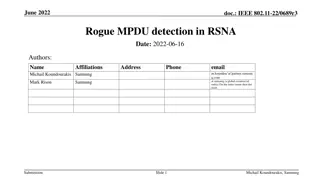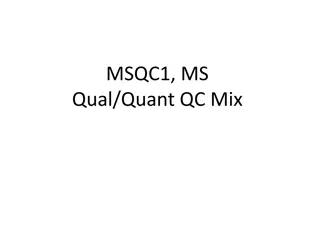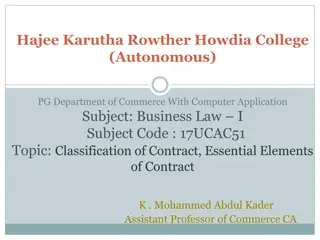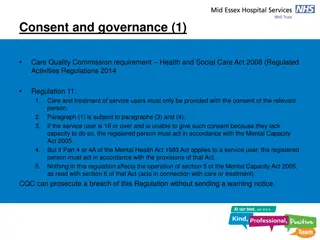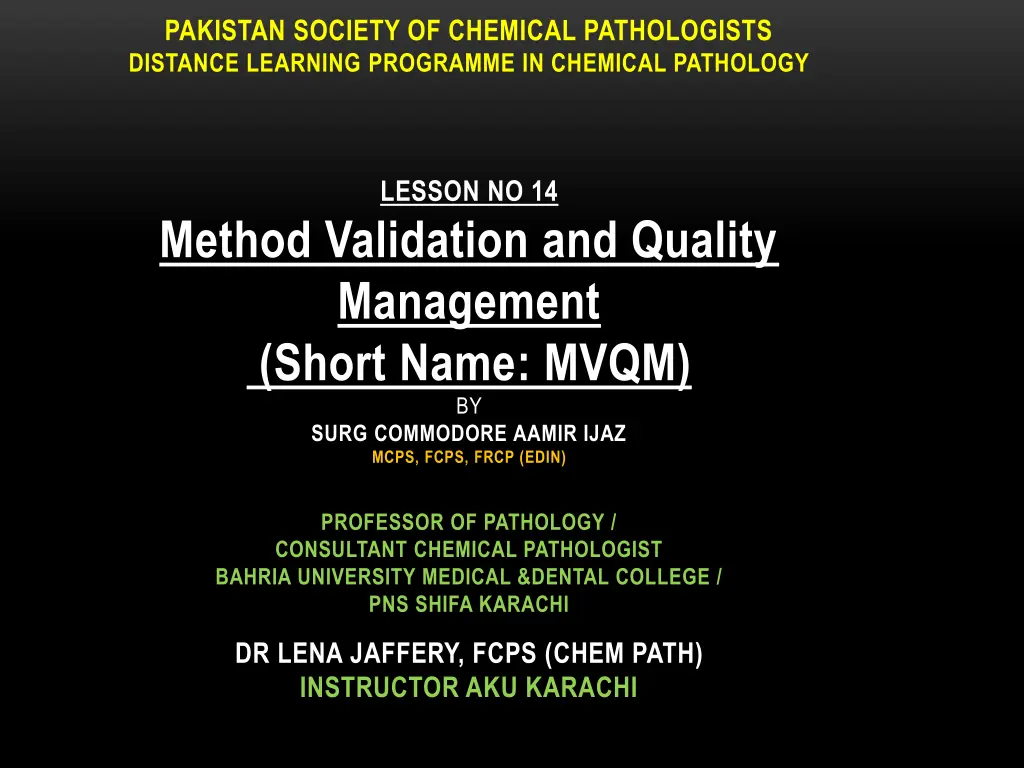
Chemical Pathology Lesson on Method Validation and Quality Management
"Explore the intricacies of method validation, quality management, and standard deviation index in chemical pathology. Learn about method evaluation versus validation and enhance your understanding of laboratory processes."
Download Presentation

Please find below an Image/Link to download the presentation.
The content on the website is provided AS IS for your information and personal use only. It may not be sold, licensed, or shared on other websites without obtaining consent from the author. If you encounter any issues during the download, it is possible that the publisher has removed the file from their server.
You are allowed to download the files provided on this website for personal or commercial use, subject to the condition that they are used lawfully. All files are the property of their respective owners.
The content on the website is provided AS IS for your information and personal use only. It may not be sold, licensed, or shared on other websites without obtaining consent from the author.
E N D
Presentation Transcript
PAKISTAN SOCIETY OF CHEMICAL PATHOLOGISTS DISTANCE LEARNING PROGRAMME IN CHEMICAL PATHOLOGY LESSON NO 14 Method Validation and Quality Management (Short Name: MVQM) BY SURG COMMODORE AAMIR IJAZ MCPS, FCPS, FRCP (EDIN) PROFESSOR OF PATHOLOGY / CONSULTANT CHEMICAL PATHOLOGIST BAHRIA UNIVERSITY MEDICAL &DENTAL COLLEGE / PNS SHIFA KARACHI DR LENA JAFFERY, FCPS (CHEM PATH) INSTRUCTOR AKU KARACHI
Extended Matching Questions (EMQs)
m. Method Evaluation a. Analytical Errors n. Method Implementation b. Analytical Measurement Range o. Method Validation c. Comparison of Method Experiment d. Constant Systemic Error p. Post-analytical Errors e. Correlation Coefficient q. Pre-analytical Errors f. Delta Check r. Proportional Systemic Error g. Differential Plot s. Random Error h. F Test t. SDI i. Instrument Calibration u. Six Sigma j. Internal Quality Control v. T Test k. Lower limit of Detection w. Trouble Shooting l. Lower limit of Quantification x. Verification of Instrument Calibration y. Z-Value
Q:1. An important parameter given in National External Quality Assurance Programme showing performance of a participating lab and calculated by following formula: Lab Result- Method Mean SD Best match: t. SDI
Standard Deviation Index (SDI) This term is commonly used in External Quality Assurance (EQA) programmes. It is an indicator of accuracy of EQA samples as it provides a comparison with target value. It is quite close to the statistical term Z-value or Z- score but this term is more generalized and may be used in any situation.
Q:2. A Researcher has developed a new method for his research project. He wants to know whether his method is appropriate to carry out research or not. Best match: m. Method Evaluation
Method Evaluation vs Method Validation Method Evaluation : Highly complex methods should be studied more thoroughly. Any methods that are modified or developed by the laboratory itself must be evaluated extensively. Method Validation: The term used for most moderately complex methods that have been well studied by manufacturers as part of their own development process. The laboratory, therefore ,can perform less extensive studies to validate method performance.
Regulatory Laws and Bodies CLIA: Clinical Laboratory Improvement Act (USA) ISO: International Standard Organization ISO 15189: Standard dealing with Clinical Laboratories CAP: College of American Pathologists PNAC: Pakistan national Accreditation Council
ISO Terminology Measurandrefers to the particular analyte or test. Trueness: is used to describe the closeness of agreement between the mean obtained from a large serious of measurements and a true value. This is equivalent to the terms bias and systematic error Uncertaintydescribes a range of values that correspond to a given test result, e.g., a test result of 200 may have a standard uncertainty (SD, CV) of 4 units or 2%,.This concept sounds and looks similar to precision, but the estimate of uncertainty also incorporates any bias or trueness, thus it is actually closer to the idea of total error.
Q:3. Chemical Pathologist Resident has been assigned a task by her supervisor to evaluate the effects of lipaemia on the estimation of ALT. Best match: d. Constant Systemic Error
Constant Systematic Error Factors contributing to constant error are independent of analyte concentration, caused by; An interfering substance in all samples or in reagents that give rise to a false signal. Non chemical source e.g. improper blanking of samples or the reagents.
Interfering Substance Reaction between interfering substance and the reagent; Lack of Specificity. Substance interfering in the reaction between reagent & analyte (in coupled enzymatic methods using oxidase per oxidase reaction, hydrogen per oxide intermediate is destroyed by endogenous reducing agents e.g. ascarbic acid. Interfering substance may also inhibit or destroy the reagent, so it remains in suboptimal amount for the reaction with analyte.
Interfering Substance (cont) Hemolysis Lipemia Icterus Related compounds Drugs Dietary substances Sample additives etc.
Evaluation Experiments for Estimating Specific Types of Analytical Errors Type of Analytical Error Evaluation Experiments Preliminary Final Interference Comparison with Comparative Method Constant Systematic Error
Q:4. Chemical Pathologist Resident has plotted the readings of Quality Control material on a Levey-Jennings (LJ) plot and applied Westguard rules. Best match: j. Internal Quality Control
Q:5. Consultant Chemical Pathologist wants to determine the lowest level of TSH which can be reported with accuracy and precision.. Best match: l. Lower Limit of Quantification
Verification of Limit of Detection (LOD) and Limit of Quantitation (LOQ) LOD is the smallest amount that the method can detect to determine presence or absence of analyte. LOQ is the smallest amount the method can measure quantitatively. Conventionally LOD is defined as the lowest value that significantly exceeds the measurements of a blank sample.
Q:6. Defining the standard operating procedures and documenting the procedure, selecting an appropriate Quality Control material for monitoring routine performance, and training personnel to operate the new method. Best match: n. Method Implementation
Q:7. Head of the Department of Chemical Pathology has instructed all his residents to check whether the adjustable pipettes of the Department are working properly or not. They test the pipettes using gravimetric measurement of various volumes of distal water measured by these pipettes. Best match: x. Verification of Instrument Calibration
QC of Instruments Instrument Calibration : Carried by professional organization either at the time of manufacturing or later as part of maintenance. Verification of Instrument Calibration : This is a procedure adopted by the end-user for routine maintenance. It is also part of the QC of intsruments which all lab staff should know and master.
Q:8. In a new Laboratory Reagent kit of Beta HCG the Chemical Pathologist wants to determine the highest level of the Beta HCG which can be reported without dilution. Best match: b. Analytical Measurement Range
Analytical Measurement Range (AMR) Range of analyte values that a method can directly measure on the specimen, without any dilution, or other pretreatment, not part of the usual assay process. AMR must be verified before a method is introduced, and checked at least every 6 months (and after recalibration or major maintenance) while in use.
AMR (cont) AMR verification must include three levels low, midpoint, high. One can use commercial linearity materials, proficiency testing (PT) samples or patient samples with known results, standards or calibrators. It can also be done by calibration verification, if three samples that span the measurement range are used. In the absence of commercial materials, one will need to create one s own materials. High and low samples can be mixed to create a mid-point sample.
The linear-data plotter It is used with the data collected in the linearity experiment, where the purpose is to assess the analytical range over which patient results may be reported. The response of the method is plotted on the y-axis versus the relative concentration or assigned values of the samples or specimens on the x-axis. The reportable range is generally estimated as the linear working range of the analytical method.
Clinically Reportable Range (CRR) It is the range of analyte values that are reported as a quantitative result, allowing for specimen dilution or other pretreatment used to extend the actual AMR. CRR is a clinical decision by the laboratory director, and does not require experiments or re- validation; however, dilution or concentration protocols must be specified in methods.
solutions and utilizing a curve-fitting routine to establish the calibration function.
Q:9. In a tertiary care hospital a Consultant Chemical Pathologist has joined the department after getting training from Japan. Although the Quality Control (QC) and the External Quality Assurance (EQA) results are acceptable, he is not happy with the performance of the lab. He launches a new programme for a marked reduction of the lab errors and sets a target of < 3.4 errors per million. Best match: u. Six Sigma
Whats in a name? Sigma is the Greek letter representing the standard deviation of a population of data Sigma is a measure of variation (the data spread)
What does variation mean? Variation means that a process does not produce the same result every time 20 15 10 5 0 Some variation will exist in all processes -5 -10 Variation directly affects customer experiences
The pizza delivery example . . Customers want their pizza delivered fast! Guarantee = 30 minutes or less We measured performance and found an average delivery time of 23.5 minutes? On-time performance is great, right? Our customers must be happy with us, right?
How Often are we Delivering on Time? Answer: Look At The Variation! 30 min. or less s x 0 10 20 30 40 50 Managing by the average doesn t tell the whole story. The average and the variation togethershow what s happening.
Introduction to six sigma Statistical measure of quality Based on rigorous process based performance Process for continuous improvement To improve process in any business Changes ways of thinking Creates a special infrastructure of people within the organization Defects per million 1 million =1000,000
Relating sigma to defect levels DPMO Error free rate (Defects per million opportunities) Six sigma Five sigma Four sigma Three sigma Two sigma One sigma 3.4 233 6210 66810 308500 691500 99.9997% 99.977% 99.4% 93% 69% 31%
In short Processes that operate with "six sigma quality" over the short term are assumed to produce long-term defect levels below 3.4 defects per million opportunities
Q:10. Lab Technologist has spiked a sample of serum with 10% glucose and estimated the difference in glucose concentration in this sample before and after the spiking. Best match: r. Proportional Systemic Error
Proportional Systematic Error An error that is always in one direction, and the magnitude of which is percentage of concentration of analyte being measured. It is most often caused by incorrect assignment of the amount of substance in the calibrator. If the calibrator has more analyte than is labeled (120 mg/dl glucose instead of 100 mg/dl which is labeled on calibrator), all unknown determinations would be low, and vise versa.
Proportional Systematic Error (Cont) Proportional error may also be caused by side reaction of the analyte e.g. metabolite of the analyte also contributing in the reaction Higher analyte concentration with higher metabolite giving higher percentage of error.
Evaluation Experiments for Estimating Specific Types of Analytical Errors Type of Analytical Error Evaluation Experiments Preliminary Final Recovery Comparison with Comparative Method Proportional Systematic Error
Q:11. On arrival of new stock of reagent kits of Cholesterol, a Resident Chemical Pathologist carries out an experiment lasting for 40 days. After this experiment he calculates the bias and applies t Statistic for determination of error. Best match: c. Comparison of Method Experiment
The Comparison Of Methods Experiment (The Mother Of Experiments)
Final Experiment for Accuracy a. Patient samples with a wide range of values e.g. Serum Cholesterol levels from 3.0 mmol/L to 7.0 mmol/L are used for the tests. b. Every day 5-8 samples are estimated c. Test lasts for 40 days d. Then bias is calculated. e. Statistics are applied.
Statistics used for Comparison of Method Linear Regression Stat t Statistics
Q:12. Pathologist has carried out Serum Calcium level in a control material for 30 times consecutively and calculated Mean and SD. Best match: s. Random Error










